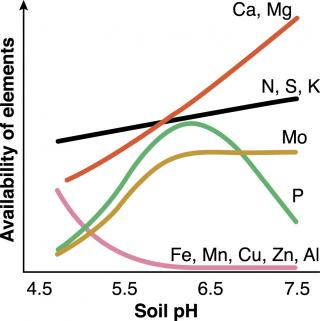Nutrient availability
Deficiencies of major plant nutrients often occur in acidic soil because nutrients are less available to plants.
The availability of nutrients to plants is altered by soil pH (Figure 5). In acidic soils, the availability of the major plant nutrients nitrogen, phosphorous, potassium, sulfur, calcium, magnesium and also the trace element molybdenum is reduced and may be insufficient.

In addition to being chemically less available to plants, nutrients may also be positionally less available due to poor root growth in acidic soils. When root growth is restricted, plants are unable to explore sufficient soil volume to compensate for the reduced chemical availability. In this case, more nutrients than should be necessary would be required for optimal plant growth, however reduced root growth into the subsoil would still limit access to water deeper in the profile.
A 2012 Department of Primary Industries and Regional Development trial at Wongan Hills showed that where lime, but no phosphorus fertiliser, was applied, plant uptake of phosphorus increased. This indicates that soil acidity reduced the availability of phosphorus in the unlimed plots even though it was present in the soil. Additional phosphorus (20 kilograms per hectare) only increased wheat grain yield where lime was also applied (Scanlan et al. 2013).
Phosphorus levels in many WA south-west agricultural soils now exceed more than is required for optimal production, however over 50% of these soils are also below pH 5.5, which can reduce uptake of phosphorus and other nutrients (Weaver and Summers 2013). Liming to raise the pH of acidic soil will increase the availability of these nutrients.
The availability of iron, manganese, copper, zinc and aluminium are increased in acidic soils. In WA, toxic levels of aluminium is usually the only problem. Manganese toxicity can occur in acidic soil in the eastern states of Australia. However, concentrations are rarely high enough in WA wheatbelt soils to be toxic even at low soil pH.
